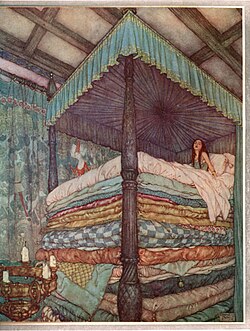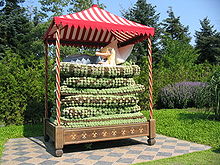The Princess and the Pea
| "The Princess and the Pea" | |
|---|---|
| Short story by Hans Christian Andersen | |
 1911 Illustration by Edmund Dulac | |
| Original title | Prinsessen paa Ærten |
| Translator | Charles Boner |
| Country | Denmark |
| Language | Danish |
| Genre(s) | Literary fairy tale |
| Publication | |
| Published in | Tales, Told for Children. First Collection. First Booklet. 1835. |
| Publication type | Fairy tale collection |
| Publisher | C.A. Reitzel |
| Media type | |
| Publication date | 8 May 1835 |
| Published in English | 1846 in A Danish Story-Book |
"The Princess and the Pea" (Danish: Prinsessen paa Ærten, lit. 'The Princess on the Pea')[1] is a literary fairy tale by Hans Christian Andersen about a princess who is tested to become wife to a lonely prince. The tale was first published with three others by Andersen in a cheap booklet on 8 May 1835 in Copenhagen by C. A. Reitzel.
The tale is classified in the Aarne–Thompson–Uther Index as ATU 704, "The Princess and the Pea".[2]
Plot
The story tells of a prince who wants to marry a true princess but is having difficulty finding a suitable wife. He meets many princesses, but is never sure that they are real (Danish: rigtig, lit. 'rightful') princesses—until one stormy night, when a mysterious young woman drenched with rain seeks shelter in the prince's castle. She claims to be a princess, but the prince's mother, the queen, has doubts. She decides to test their unexpected guest by placing a hard uncooked vegetable pea in the bed she is offered for the night, covered by twenty mattresses stacked on top.
In the morning, the mysterious woman tells her hosts that she endured a rather restless night, kept awake by something in the bed that made her feel uncomfortable. The prince's family realizes that she is a princess after all, since only a true princess could be sensitive enough to feel a little pea under all those mattresses. The Prince and the Princess are happily married, and the story ends with the pea being placed in a museum, where it might still remain.
Commentaries
Researcher Jack Zipes said that Andersen, during his lifetime, "was obliged to act as a dominated subject within the dominant social circles despite his fame and recognition as a writer." He therefore had a mixed opinion of the upper classes, at the same time aspiring to them and scorning them. According to Zipes and other writers, this tendency found expression in Andersen's stories, where people like the princess undergo ordeals to prove their virtuousness.[3]
While a 1905 article in the American Journal of Education recommended the story for children aged 8–10,[4] "The Princess and the Pea" was not uniformly well received by critics. Toksvig wrote in 1934, "[the story] seems to the reviewer not only indelicate but indefensible, in so far as the child might absorb the false idea that great ladies must always be so terribly thin-skinned."[5]
"The Princess and the Pea" spurred on positive criticism, as well. In fact, critic Paul Hazard pointed out the realistic aspects of the fairy tale that make it easily relatable to all people. He believed that "the world Andersen witnessed—which encompassed sorrow, death, evil and man's follies—is reflected in his tales," and most evidently in "The Princess and the Pea." Another scholar, Niels Kofoed, noticed that “since they involve everyday-life themes of love, death, nature, injustice, suffering and poverty, they appeal to all races, ideologies, classes and genders.” Moreover, Celia Catlett Anderson realized that one of the things that makes this story so appealing and relatable is that optimism prevails over pessimism, especially for the main character of the princess. This inspires hope in the readers for their own futures and strength within themselves.[3]
Adaptations
In 1927, German composer
Similar tales

A few folk tales feature a boy discovering a pea or a bean assumed to be of great value. After the boy enters a castle and is given a bed of straw for the night he tosses and turns in his sleep, attempting to guard his treasure. Some observers are persuaded that the boy is restless because he is unaccustomed to sleeping on straw and is therefore of aristocratic blood.
References
Citations
- ^ a b c Tatar (2008), pp. 70–77
- ^ Haase, Donald, ed. (2008). The Greenwood Encyclopedia of Folktales and Fairy Tales. Greenwood Publishing Group. p. 798.
- ^ a b Dewsbury, Suzanne, "Hans Christian Andersen- Introduction", Nineteenth-Century Literary Criticism, Gale Cengage, archived from the original on 29 March 2015, retrieved 3 May 2012
- JSTOR 42806381
- ^ Toksvig (1934), p. 179
- ^ JSTOR 893051
- JSTOR 950468
- JSTOR 20201188
- ISBN 978-0-670-84487-6
- JSTOR 20595894
- JSTOR 128363
- ^ Heiner, Heidi Anne (2021), "History of The Princess and the Pea", SurLaLune Fairy Tales, retrieved 9 July 2023
Bibliography
- ISBN 0-8154-1105-7
- de Mylius, Johan (2009), "The Timetable Year By Year, 1835: The First Collection of Fairy-Tales", H.C. Andersens liv. Dag for dag. (The Life of Hans Christian Andersen. Day By Day.), The Hans Christian Andersen Center, retrieved 8 February 2009
- Opie, Iona; ISBN 0-19-211559-6
- ISBN 978-0-393-06081-2
- Macmillan and Co.
- Wullschlager, Jackie (2000), Hans Christian Andersen: The Life of a Storyteller, ISBN 0-7139-9325-1
- ISBN 0-415-97433-X
Further reading
- Bataller Català, Alexandre. (2018). «La princesa i el pèsol» (ATU 704): de les reescriptures escolars a la construcció identitària. Estudis de Literatura Oral Popular / Studies in Oral Folk Literature. 27. 10.17345/elop201827-46.
- Shojaei Kawan, Christine. (2005). The Princess on the Pea: Andersen, Grimm and the Orient. Fabula. 46. 89–115. 10.1515/fabl.2005.46.1-2.89.
External links
- "Prindsessen på Ærten" Original Danish text 2008 archive
- "The Princess on the Pea" English translation by Jean Hersholt
- Archived audio version of the story
 The Princess and the Pea public domain audiobook at LibriVox
The Princess and the Pea public domain audiobook at LibriVox
